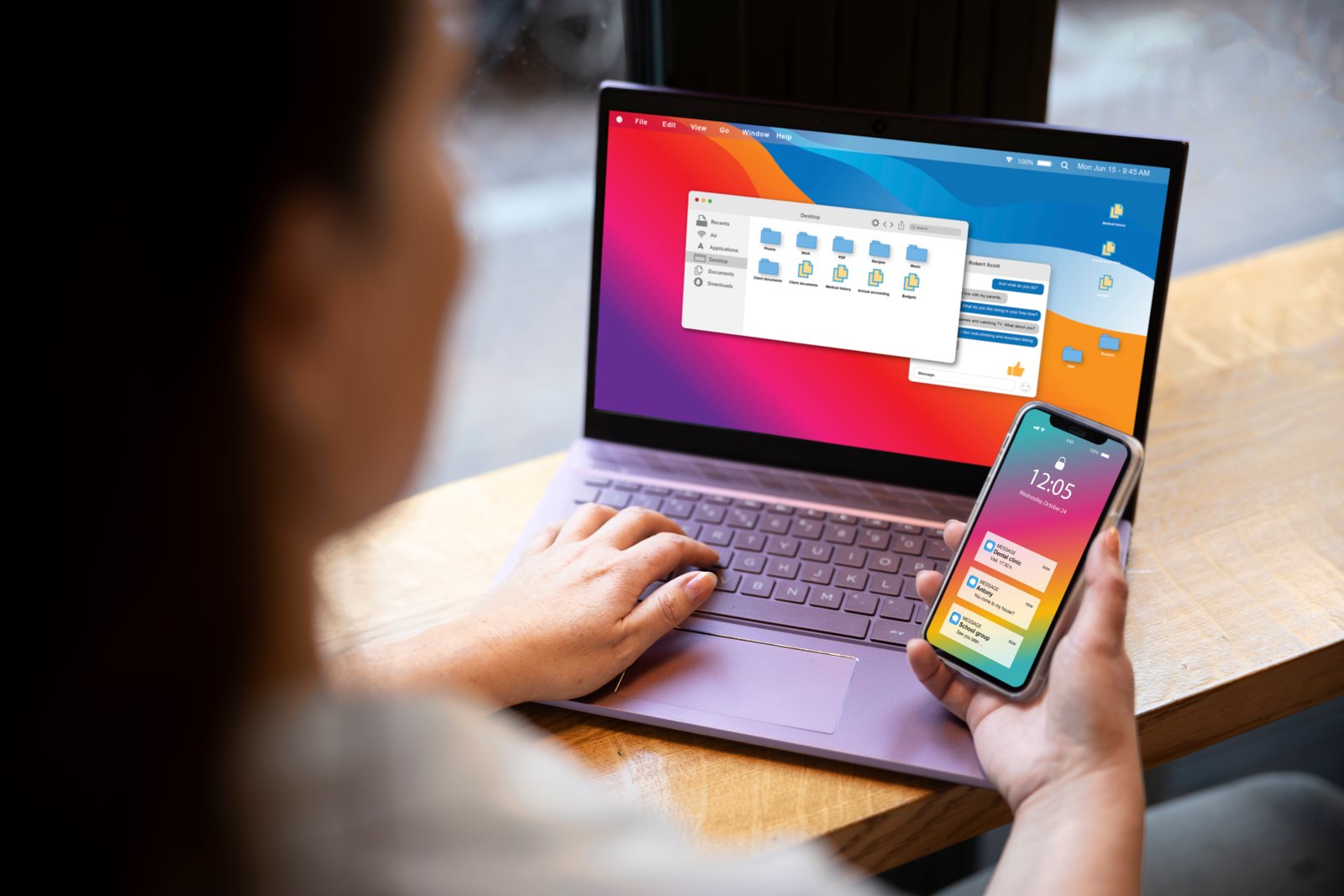How to Improve BYOD Security: C-Levels Personal Data Protection
BYOD (Bring Your Own Device) has gained popularity in recent years due to several factors, including the growing adoption of mobile devices and the need for flexibility in the workplace.
Read on to learn more about this trend and how it affects the organization’s security and C-Levels.
What is BYOD, and what is its relevance to companies?
BYOD (Bring Your Own Device) is the company policy that allows employees to use their devices, such as smartphones, tablets, and laptops, to access corporate systems and data and perform work activities. This practice typically includes accessing corporate email, business applications, documents, and other company resources.
BYOD implementation varies by company but typically involves installing security and management software on personal devices to protect corporate data.

Why has BYOD become popular?
The emergence and adoption of BYOD policy in companies has been driven by various causes related to the business environment and the global market. These have created the right scenario for companies to adopt BYOD policies and take advantage of their benefits.
- Increased labour mobility. Employees can now work from anywhere and anytime, which has caused companies to look for solutions that allow this flexibility.
- Demand for flexibility from employees. New generations of workers value flexibility and autonomy at work. BYOD allows employees to use devices they are familiar with and comfortable with, which can improve their satisfaction and retention.
- Reduction of operating costs. Allowing employees to use their own devices reduces hardware and maintenance expenses, which is especially beneficial for small and medium-sized businesses.
- Technological advances. The rapid evolution of mobile technology has made personal devices increasingly powerful and capable of handling complex work tasks.
- Enhanced connectivity. The expansion of high-speed networks has improved global connectivity, allowing employees to access corporate systems and data quickly and efficiently from anywhere.
- Growth of remote work. The COVID-19 pandemic accelerated the adoption of remote work around the world. Many businesses were forced to adapt to this new reality quickly, and BYOD became a viable solution for allowing employees to work from home.
- Security and device management. Developing advanced device management and security solutions has enabled enterprises to implement BYOD policies securely.
Advantages and disadvantages of BYOD in companies
BYOD has many advantages and disadvantages that businesses should consider before implementing it to ensure successful and safe adoption.
Advantages of BYOD
- Increased productivity. Employees tend to be more productive when they use devices that they are familiar with and comfortable with. Learning time is reduced, and efficiency in the completion of tasks is increased.
- Cost reduction. Companies reduce purchasing and maintaining hardware costs by allowing employees to use their devices. This is especially beneficial for small and medium-sized businesses with limited budgets.
- Flexibility and employee satisfaction. BYOD allows employees to work from anywhere and anytime, improving work-life balance and, thus, satisfaction. For the company, this translates into more significant talent attraction and retention.
- Innovation and technological updating. Individuals generally tend to update their devices more frequently than businesses, which means they may have access to newer, more advanced technology.
Disadvantages of BYOD
- Safety. The security of information, data, and communications is the primary concern, as personal devices can be more vulnerable to cyberattacks.
- Device compatibility and management. Managing various devices and operating systems can become complex and require additional resources.
- Employee privacy. Implementing management and security software on personal devices raises employee privacy concerns. Establishing clear and transparent policies to protect employees’ data is essential.
- Hidden costs Although BYOD reduces hardware costs, it can sometimes carry hidden costs associated with implementing and managing the policy.
BYOD Security Challenges and How They Affect C-Levels
While security issues within the BYOD system remain, those that affect C-levels are more relevant to the organization due to their high capacity for action.
Risks of BYOD to C-Levels Personal Data Privacy
When it includes C-levels, BYOD carries the same risks and threats as when applied to any other employee. However, the type of information they handle and the activity that C-levels have access to within the organization make the associated risks more critical.
- Sensitive data: C-Level personal devices used as BYOD contain critical information about the organization. In addition, they contain a large amount of personal data that can be used to put the person and the organization at risk.
- Spear Phishing and Whale Phishing: Senior executives are attractive targets for highly targeted spear phishing attacks and other forms of social engineering.
- Lost or stolen devices: Personal devices are more susceptible to loss or theft, which can expose critical corporate data, especially for C-levels.
- Use of unsecured Wi-Fi networks: Connecting to public or unsecured Wi-Fi networks from personal devices during private activities is common.
- Security updates: Awareness of the need to keep personal devices up to date may be lower and may even conflict with some use outside the device’s work environment (e.g., lack of sufficient memory).
- Mix of personal and work use: Combining personal and work data on the same device can easily lead to unauthorized access and exposure of sensitive information.
Common Security Threats to Using Personal Devices at Work
Using personal devices at work presents several security threats common for any worker, regardless of the responsibility of their position within the organization.
- Malware and malicious applications. Personal devices can download apps that contain different types of malware and compromise business data security.
- Phishing. Phishing attacks arrive through emails, SMS messages, social networks, and other applications to trick users into revealing sensitive information.
- Ransomware. This type of malware encrypts the data on the device and demands a ransom to release the information. Personal devices are often more vulnerable to these attacks.
- Unauthorized access. Personal devices are used in various places and situations, making unauthorized access easier.
- Insecure Wi-Fi networks. Connecting to public or unsecured Wi-Fi networks exposes devices to attacks and unauthorized access and is a common practice when in a public place with a personal device.
- Lost or stolen devices. If a personal device is stolen or lost, corporate and personal data can fall into the wrong hands

Strategies to mitigate risks and protect critical data
To mitigate or nullify the risks associated with BYOD, there are many recommended cybersecurity strategies:
- Cybersecurity training: Train employees on security best practices, such as safely identifying phishing emails and using personal devices.
- Digital identity protection: Implement strong authentication measures, such as multi-factor authentication (MFA), to ensure that only authorized users access sensitive data.
- Zero Trust Architecture: Adopting a security approach based on the concept of Zero Trust that involves continuously verifying the identity and context of users.
- Behavior-based protection: Use security solutions that detect and block suspicious device behavior.
- Update and Patch Policy: Ensure that all personal devices used for work are up-to-date with the latest security patches and software.
- Data encryption: Implement data encryption at rest and in transit to protect sensitive information in the event of lost or stolen devices.
- Continuous monitoring: Conduct regular audits and assess the use of personal devices to quickly detect and respond to any security incidents.
Practices to improve BYOD security in C-Level profiles
It is essential to carry out a series of cybersecurity practices to mitigate risks and protect critical data in company C-Level profiles with a BYOD policy.
Recommended technologies for protecting data on BYOD devices
Some technologies that can be incorporated into C-Level BYOD devices include
- MDM (Mobile Device Management). It enables businesses to manage and secure mobile devices. With MDM, you can enforce security policies, control applications, and perform remote wipes in case of loss or theft.
- MAM (Mobile Application Management). More restrictive than the previous one, it focuses on managing specific applications instead of the entire device. This allows controling access to corporate applications and protect data within them.
- VPN (Virtual Private Network). It provides a secure, encrypted connection between the device and the corporate network, protecting data in transit from potential interceptions.
- Data encryption Encrypting the data stored on the devices is essential to protect it in case of loss or theft. Data encryption ensures that only authorized users can access the information.
- Multi-factor authentication (MFA). It adds an extra layer of security by requiring multiple verification forms before granting access to data or applications.
- Security containers. They separate corporate data from personal data on the device, ensuring that sensitive information is protected and not mixed with personal data.
Updated security policies
Regularly updating corporate security policies is essential to improving BYOD security, especially for C-Level profiles.
These periodic updates must include adapting policies to new threats, approving new legal regulations, conducting the latest risk assessments, applying new technologies and security protocols, providing staff training, and implementing changes in the organization’s business structure or operational processes.
Staff training
To improve BYOD security in senior management profiles, it is important to design a specific training plan for C-Levels that considers their particular responsibility.
Such training should integrate awareness of general and particular threats, security best practices, compliance, incident management, cybersecurity culture, and, crucially, risk assessment, taking into account the specific context of each C-Level.
You may be interested in our publication→ Cybersecurity risk management for C-Levels.
Featured Examples of BYOD in Enterprises
BYOD is a policy followed by various companies, from small startups to large multinational corporations. Due to their work’s mobile and flexible nature, technology and professional services companies are some of the most adopting this policy.
However, growing adoption is also seen in sectors such as education, health, and finance, where mobility and quick access to information are crucial.
Some prominent examples of companies that have successfully implemented BYOD include:
- IBM: Allows employees to use their devices to access corporate applications and data.
- Cisco: Uses BYOD to encourage employee flexibility and mobility.
- SAP: The company has experienced improvements in productivity and employee confidence since implementing BYOD.
- Unisys: The BYOD policy has enabled employees to work more flexibly and efficiently.
The Future of BYOD in companies and its Impact on Data Security
The future of BYOD in enterprises looks promising, but it poses significant challenges regarding data security. Allowing employees to use their devices to access corporate systems and data has gained popularity due to its potential to increase productivity and satisfaction. However, this practice also introduces security risks that companies need to address.
One of the main challenges is protecting sensitive data. Personal devices typically lack the same levels of security as corporate devices, making them more vulnerable to cyberattacks. In addition, the diversity of devices and operating systems can make it difficult to implement uniform security policies.
To mitigate these risks, companies must adopt comprehensive approaches to security. This includes implementing personal device management and automated monitoring solutions for real-time detection of data breaches and the breaches that have caused them. Educating employees on security best practices and establishing clear policies on using personal devices is also crucial.
Find out how Enthec can help you protect your organization’s sensitive information and its C-Levels
Through its automated and continuous monitoring solutions, Enthec locates leaked and exposed sensitive information, neutralizing its use to carry out successful cyberattacks and detecting security breaches in the systems or devices that have caused them.
If you need to know more, do not hesitate to contact us.
